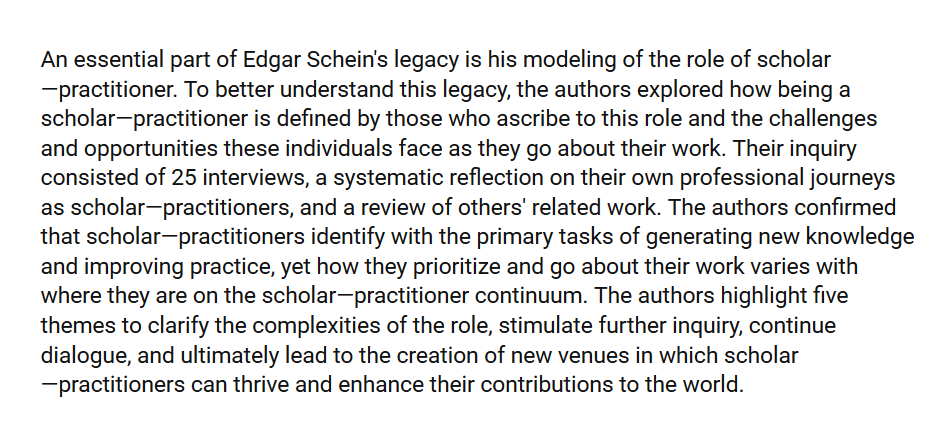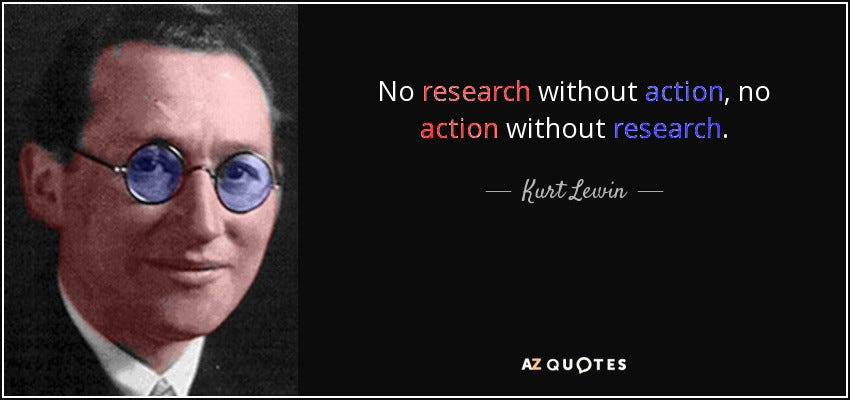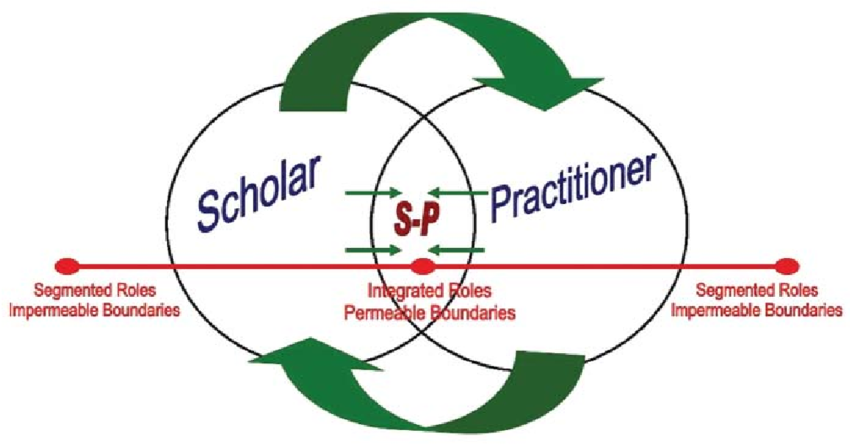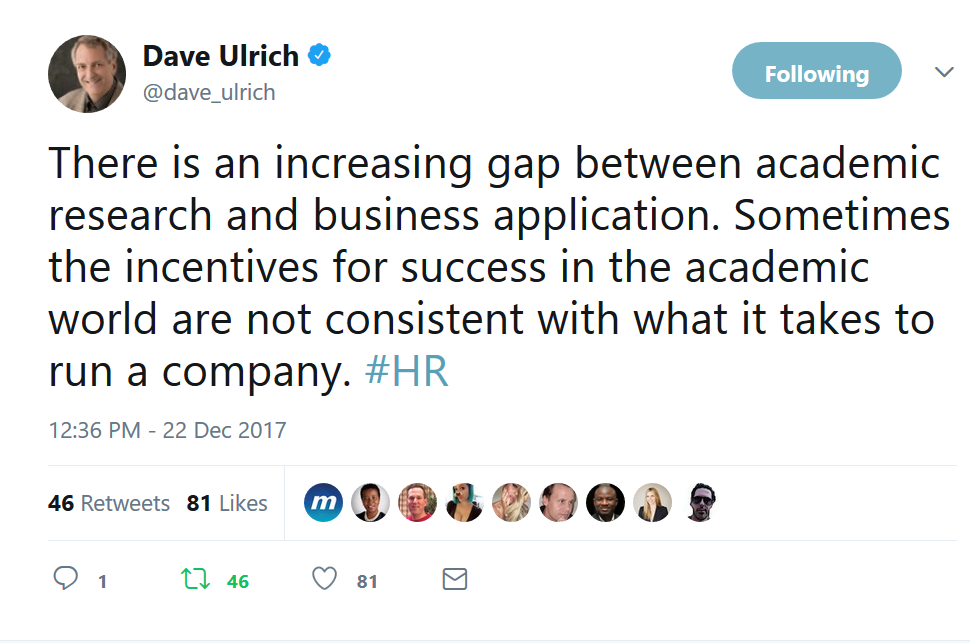
Is the Scientist-Practitioner Gap an Impossible Chasm of Despair?You do not need to have 50 years experience or be a world renowned PhD “brand name” to walk freely across the science-practice divide.We recently read an article from 2009 by Ilene Wasserman & Kathy Kram entitled “Enacting the scholar — practitioner role: An exploration of narratives”. It is a short article to read, and freely available on researchgate etc. Here is the abstract:
We found the article to be very interesting and it stimulated our thinking and discussion about the “science-practitione” gap. On one side of this gap there are the scholars and scientists, people who generate and demonstrate robust, evidence-based new insights, and on the other there are the practitioners, people with their feet in the day-to-day reality of making organizations function better. Very few people are both at the same time, and that creates a distance between organizational science and OD practice.
One of our favorite quotes from the literature search section of the paper was:
“In this article, we make a distinction between crossing boundaries (e.g., exploring venues and possibilities that foster relationships and professional exchanges between people who primarily identify as one or the other) and boundary spanners, or people who are doing both.”
The concept of “boundary spanners” really speaks to the imagination. It is the kind of role that is essential for both the science and the practice side of the boundary, to make sure that knowledge grows and is applied well.
The paper is a short qualitative study of 25 high level Organization Development practitioners and academics. That may sound small, but it is not uncommon in qualitative research.
More interesting are the themes the researchers found through their grounded theory approach. These included
- “Major Dilemmas”, relating to the fundamentally different nature of the world of academia and that of practice at the coalface, each with their own rhythms, demands, and areas of focus
- “Motivations and Drivers for the work”, relating to the career choices the participants had made to step from academia to the real world or the other way round,, and what factors had motivated them (money, status, scientific work etc)
- “Subcultures and Places we call Home”, including the rules and terms of engagement in the workplace, for example in academia as opposed to in practice.
While the participants differed in many ways, what struck us was what they shared:
“Most participants articulated, explicitly or implicitly, a need to create more bridges, roles, and meeting spaces to support and connect the work of individuals who value practice in the service of building new theory and those who value theory in the service of practice. Both the academic and practice subcultures were, in effect, undermining integration of these two aspects of the work and perpetuating considerable role conflict that was difficult to manage.”
We completely agree with these thoughts.
We would like to think there is a way to build on the findings from the article. What could we learn if participants came from a wider background — members of the Organization Development Network for example? Or perhaps more diversity regarding where people landed on the scholar/practitioner continuum?. But interviewing hundreds of people would be very resource intensive. And what more could be learned? Would the same themes evolve? Would it produce granular information? Or would it reveal that the divide between scholars and practitioners is just much greater in a larger population of OD professionals?
Or would it make sense to carry out a quantitative study? Not to disparage the current article, but what if it were considered a pilot study to springboard into a study where the themes were used to develop an assessment of sorts so that OD professionals and those in related disciplines could assess their current ability to span boundaries? What if this could then be segmented by demographic variables such as time in profession, or primary identification as scholar or practitioner? Clearly, there are many questions and opportunities that could be addressed by more research in this area.
“We suspected that the scholar–practitioner could best be understood as a continuum of roles, rather than just one identity where pure scholar and pure practitioner anchor each end of the continuum. Individuals may place themselves at different points on the continuum as the emphasis in their work shifts, their careers unfold, and they form different partnerships and collaborations.”
The article definitely made us think of some of the bigger implications of the divide between the scholar and practitioner. A striking example is that of the 1988 Connie Gersick article “Time and Transition in Work Teams: Toward a New Model of Group Development”. With over 2,000 citations (according to Google Scholar), one would think the information on teams would be common knowledge to most, if not all, practitioners. Instead it is Bruce Tuckman’s Forming, Storming, Norming and Performing, all the way back from the mid 1960s, that is still the default approach in team* development. Tuckman’s work on team stages is taken as some kind of gospel by many practitioners, while Gersick’s lack of confirmation of the actual existence of these stages is largely ignored. Granted, Clearly something is not as it should be.
There are many reasons for the gap between research in universities and practice in the field, but one that is often quoted is the stark difference between the incentives at either side of the divide, as Dave Ulrich observes:
The Society for Industrial and Organizational Psychology (SIOP) also zooms in on this ubiquitous gap in an article from a few weeks ago, “The Scientist–Practitioner Gap Among Master’s Level I-O Psychology Practitioners: A Text-Analytic Exploration”. With a (small) group of Industrial-Organizational Psychology professionals they found issues including:
- Difficulty of accessing resources for scientific insight (e.g., paywalls)
- Lack of scientific attitude
- Uncomfortable with research/experimentation
We believe the scholar-practitioner gap is not a theoretical problem, but something that really holds back the development of management science. It most definitely forms an obstacle to more evidence-based practice. Some of us try to do translation, making evidence from academia available through podcasts, blogs, and social media, but it is a small dent in a large problem. ScienceForWork and the Future Work Centre are two examples of organizations that are working to make a big impact on narrowing the gap between science and practice. Perhaps they should join forces and call themselves the Science for the Future of Work, or the Future of Work Science or something .. :-)
What else can be done? Sure, a lot more research could be done on closing the scientist-practitioner gap. There is much to be said for cross-discipline collaboration, using more academics (instead of big consulting firms), and so on. But to many of us these can feel beyond the scope of our day to day work. And yet there is more each of us, practitioners, can do. We can share and disseminate information, we can make an active effort to incorporate research and multiple sources of evidence in our practice . This can often feel overwhelming. But it is not just up to the “thought Leaders” in the field to help close this gap. And it does not need to be a large, grant-funded project that is out of reach for many of us. We can take the first steps and see where they lead. We can bring science into small acts of daily work routines. An example to show not just that it is possible, but also how it can be done is Mark Hendy’s recent post, “One small step for HR”. In it, Mark explains how taking a bite-size approach can help bring more evidence based approach to practice. Let it be an inspiration for all of us .
Commit to small steps and start helping turn the Scientist-Practitioner Gap from a chasm of despair into a productive, multi-directional collaboration.
This story was written together with Koen Smets.
References
Gersick, C.J. (1988) Time and Transition in Work Teams: Toward a New Model of Group Development. Academy of Management Journal, Vol. 31
Wasserman, I. C., & Kram, K. E. (2009). Enacting the scholar — practitioner role: An exploration of narratives. The Journal of Applied Behavioral Science,45(1), 12–38
Additional resources to consider

























Hiç yorum yok:
Yorum Gönder